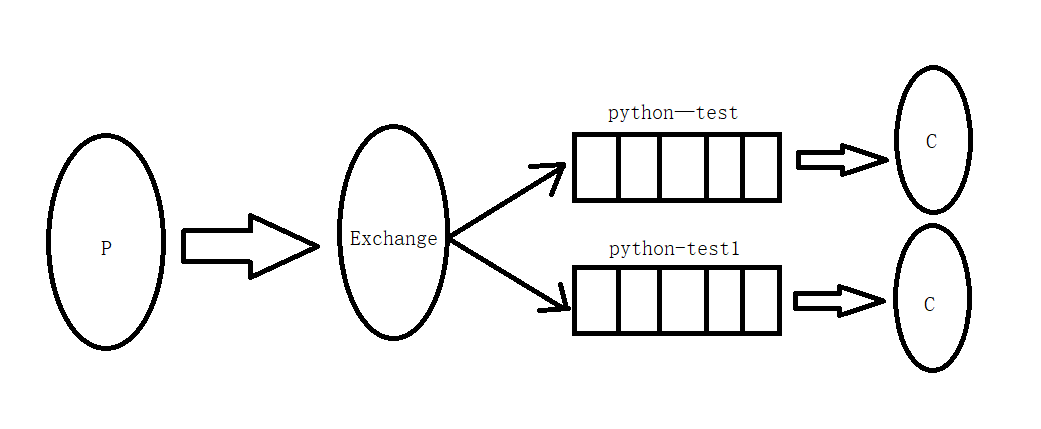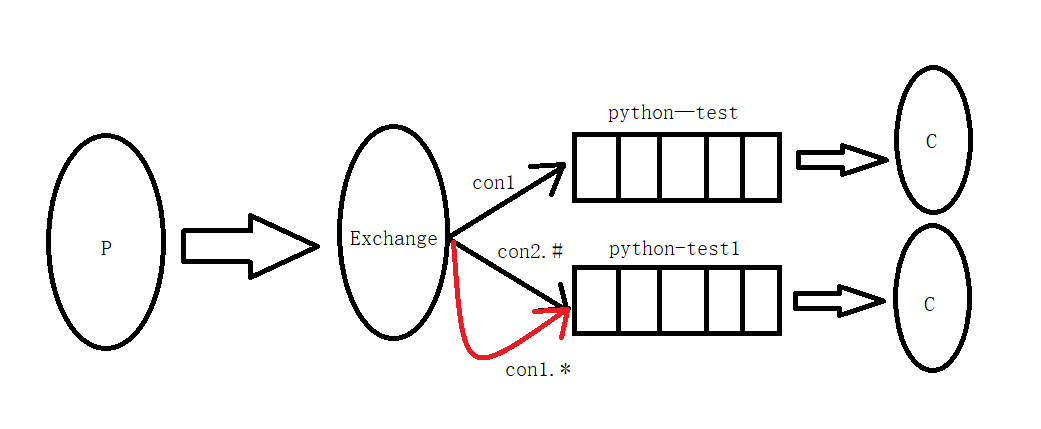Python3使用RabbitMQ
简介
AMQP,即Advanced Message Queuing Protocol,高级消息队列协议,是应用层协议的一个开放标准,为面向消息的中间件设计。消息中间件主要用于组件之间的解耦。
作用:
- 解耦
- 异步
- 削峰
使用
简单模式(直接使用队列不用交换机)

生产者:
import pika
import json
import time
credentials = pika.PlainCredentials('guest', 'guest') # mq用户名和密码
# 虚拟队列需要指定参数 virtual_host,如果是默认的可以不填。
connection = pika.BlockingConnection(pika.ConnectionParameters(host = '127.0.0.1',port = 5672,virtual_host = '/',credentials = credentials))
channel=connection.channel()
# 声明消息队列,消息将在这个队列传递,如不存在,则创建
result = channel.queue_declare(queue = 'python-test')
result = channel.queue_declare(queue = 'python-test1')
# 声明exchange,由exchange指定消息在哪个队列传递,如不存在,则创建。durable = True 代表exchange持久化存储,False 非持久化存储
# channel.exchange_declare(exchange = '',durable = True, exchange_type='fanout')
for i in range(100):
message=json.dumps({'OrderId':"1000%s"%i})
# 向队列插入数值 routing_key是队列名
channel.basic_publish(exchange='', routing_key='python-test', body=message)
channel.basic_publish(exchange='', routing_key='python-test1', body=message)
print(message)
time.sleep(2)
#connection.close()
消费者
import pika
credentials = pika.PlainCredentials('guest', 'guest')
connection = pika.BlockingConnection(pika.ConnectionParameters(host = '127.0.0.1',port = 5672,virtual_host = '/',credentials = credentials))
channel = connection.channel()
# 申明消息队列,消息在这个队列传递,如果不存在,则创建队列
channel.queue_declare(queue = 'python-test', durable = False)
# 定义一个回调函数来处理消息队列中的消息,这里是打印出来
def callback(ch, method, properties, body):
ch.basic_ack(delivery_tag = method.delivery_tag)
print(body.decode())
# 告诉rabbitmq,用callback来接收消息
channel.basic_consume('python-test',callback)
# 开始接收信息,并进入阻塞状态,队列里有信息才会调用callback进行处理
channel.start_consuming()
使用exchange
fanout模式

生产者
import pika
import json
import time
credentials = pika.PlainCredentials('guest', 'guest') # mq用户名和密码
# 虚拟队列需要指定参数 virtual_host,如果是默认的可以不填。
connection = pika.BlockingConnection(pika.ConnectionParameters(host='127.0.0.1', port=5672, virtual_host='/', credentials=credentials))
channel=connection.channel()
channel.exchange_declare(exchange='test1', exchange_type='fanout')
for i in range(100):
message=json.dumps({'OrderId':"1000%s"%i})
# 当使用交换机的时候直接把消息交给交换机就好了
channel.basic_publish(exchange='test1', routing_key='', body=message)
body=message)
print(message)
time.sleep(2)
#connection.close()
消费者
import pika
import time
credentials = pika.PlainCredentials('guest', 'guest')
connection = pika.BlockingConnection(pika.ConnectionParameters(host='127.0.0.1', port=5672, virtual_host='/', credentials=credentials))
channel = connection.channel()
# 绑定交换机
channel.exchange_declare(exchange='test1', exchange_type='fanout')
# 不指定queue名字,rabbit会随机分配一个名字
# exclusive=True会在使用此queue的消费者断开后,自动将queue删除
result = channel.queue_declare(queue='', exclusive=True)
queue_name = result.method.queue
print(queue_name)
# 将exchange与queue绑定
channel.queue_bind(exchange='test1', queue=queue_name)
# 定义一个回调函数来处理消息队列中的消息,这里是打印出来
def callback(ch, method, properties, body):
#ch.basic_ack(delivery_tag = method.delivery_tag)
print(body.decode())
#time.sleep(0)
# 告诉rabbitmq,用callback来接收对应queue的消息
channel.basic_consume(queue_name, callback)
# 开始接收信息,并进入阻塞状态,队列里有信息才会调用callback进行处理
channel.start_consuming()
direct模式
生产者
import pika
import json
import time
credentials = pika.PlainCredentials('guest', 'guest') # mq用户名和密码
# 虚拟队列需要指定参数 virtual_host,如果是默认的可以不填。
connection = pika.BlockingConnection(pika.ConnectionParameters(host='127.0.0.1', port=5672, virtual_host='/', credentials=credentials))
channel=connection.channel()
channel.exchange_declare(exchange='test_direct', exchange_type='direct')
for i in range(100):
message=json.dumps({'OrderId':"1000%s"%i})
# 当使用交换机的时候直接把消息交给交换机,并指定发布到哪个queue
channel.basic_publish(exchange='test_direct', routing_key='con2', body=message)
print(message)
time.sleep(2)
#connection.close()
消费者
import pika
import time
credentials = pika.PlainCredentials('guest', 'guest')
connection = pika.BlockingConnection(pika.ConnectionParameters(host='127.0.0.1', port=5672, virtual_host='/', credentials=credentials))
channel = connection.channel()
# 绑定交换机
channel.exchange_declare(exchange='test_direct', exchange_type='direct')
# 不指定queue名字,rabbit会随机分配一个名字
# exclusive=True会在使用此queue的消费者断开后,自动将queue删除
result = channel.queue_declare(queue='', exclusive=True)
queue_name = result.method.queue
print(queue_name)
# 将exchange与queue绑定
channel.queue_bind(exchange='test_direct', queue=queue_name, routing_key='con1')
channel.queue_bind(exchange='test_direct', queue=queue_name, routing_key='con2')
# 定义一个回调函数来处理消息队列中的消息,这里是打印出来
def callback(ch, method, properties, body):
#ch.basic_ack(delivery_tag = method.delivery_tag)
print(body.decode())
#time.sleep(0)
# 告诉rabbitmq,用callback来接收对应queue的消息
channel.basic_consume(queue_name, callback)
# 开始接收信息,并进入阻塞状态,队列里有信息才会调用callback进行处理
channel.start_consuming()
topic模式
星号(*):匹配一个单词
井号(#):匹配0个或多个单词
direct与topic都是通过消费者指定routing_key来实现绑定

当产生routing_key为con1的消息时,路由到python-test中
当产生routing_key为con1.xxx的消息时,路由到python-test1中
当产生routing_key为con2的消息时,路由到python-test1中
当产生routing_key为con2.xxx的消息时,路由到python-test1中
当产生routing_key为con2.xxx.xxxx的消息时,路由到python-test1中
import pika
import json
import time
credentials = pika.PlainCredentials('guest', 'guest') # mq用户名和密码
# 虚拟队列需要指定参数 virtual_host,如果是默认的可以不填。
connection = pika.BlockingConnection(pika.ConnectionParameters(host='127.0.0.1', port=5672, virtual_host='/', credentials=credentials))
channel=connection.channel()
channel.exchange_declare(exchange='test_topic', exchange_type='topic')
for i in range(100):
message=json.dumps({'OrderId':"1000%s"%i})
# 当使用交换机的时候直接把消息交给交换机,并指定发布到哪个queue
channel.basic_publish(exchange='test_topic', routing_key='con2', body=message)
print(message)
time.sleep(2)
#connection.close()
import pika
import time
credentials = pika.PlainCredentials('guest', 'guest')
connection = pika.BlockingConnection(pika.ConnectionParameters(host='127.0.0.1', port=5672, virtual_host='/', credentials=credentials))
channel = connection.channel()
# 绑定交换机
channel.exchange_declare(exchange='test_topic', exchange_type='topic')
# 不指定queue名字,rabbit会随机分配一个名字
# exclusive=True会在使用此queue的消费者断开后,自动将queue删除
result = channel.queue_declare(queue='', exclusive=True)
queue_name = result.method.queue
print(queue_name)
# 将exchange与queue绑定
channel.queue_bind(exchange='test_topic', queue=queue_name, routing_key='con1.*')
channel.queue_bind(exchange='test_topic', queue=queue_name, routing_key='con2.#')
# 定义一个回调函数来处理消息队列中的消息,这里是打印出来
def callback(ch, method, properties, body):
#ch.basic_ack(delivery_tag = method.delivery_tag)
print(body.decode())
#time.sleep(0)
# 告诉rabbitmq,用callback来接收对应queue的消息
channel.basic_consume(queue_name, callback)
# 开始接收信息,并进入阻塞状态,队列里有信息才会调用callback进行处理
channel.start_consuming()
存在问题
数据的重复消费
数据丢失
相关内容可以参考大佬的这篇文章https://www.jianshu.com/p/5ade5bf0dcd9
本文来自博客园,作者:糖烤栗子&,转载请注明原文链接:https://www.cnblogs.com/grocerystore/p/15114621.html





【推荐】国内首个AI IDE,深度理解中文开发场景,立即下载体验Trae
【推荐】编程新体验,更懂你的AI,立即体验豆包MarsCode编程助手
【推荐】抖音旗下AI助手豆包,你的智能百科全书,全免费不限次数
【推荐】轻量又高性能的 SSH 工具 IShell:AI 加持,快人一步
· 10年+ .NET Coder 心语,封装的思维:从隐藏、稳定开始理解其本质意义
· .NET Core 中如何实现缓存的预热?
· 从 HTTP 原因短语缺失研究 HTTP/2 和 HTTP/3 的设计差异
· AI与.NET技术实操系列:向量存储与相似性搜索在 .NET 中的实现
· 基于Microsoft.Extensions.AI核心库实现RAG应用
· 10年+ .NET Coder 心语 ── 封装的思维:从隐藏、稳定开始理解其本质意义
· 地球OL攻略 —— 某应届生求职总结
· 提示词工程——AI应用必不可少的技术
· Open-Sora 2.0 重磅开源!
· 周边上新:园子的第一款马克杯温暖上架